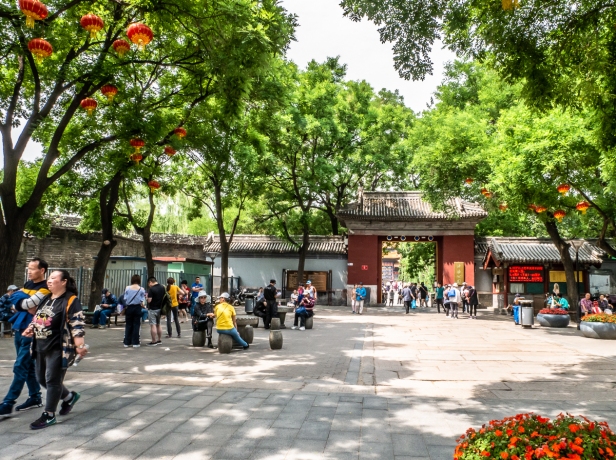
17-22 May 2018.
At 6pm we all meet in the lobby of the hotel. There are eight of us (from England, USA, Australia, and Canada) plus Peter, our guide through China for the next three weeks. Peter once told me his Chinese name and I tried to remember it, and used it a couple of times, but it didn’t stick. He said that his English teacher gave him the name Peter. Peter is easy for us westerners to say and to remember, but it felt like what it was: an overlay, creating no doubt (and appropriately) a different persona from his at home Chinese self. We visited his town, and met his young son, and saw photographs of his wife, and I can imagine him in that setting, free of tour-guide responsibilities, being a somewhat different person, the person who goes by his Chinese name. We know him as friendly, funny, knowledgeable, and efficient – a good guy and a good guide. We are lucky to have him.
After introductions we follow Peter like a badling of ducklings, our trust in him unquestioned. He leads us first by bus, and then by walking down ever-narrowing streets to a family-owned restaurant unknown to tourists in a quiet back street in one of Beijing’s hutong areas.
Once settled around the table Peter orders the most sumptuous meal: eggplant, various other vegetables, pork, lamb, omelette, kung pao chicken, and of course Peking duck. I’d heard of Peking duck of course but never seen it. I’d assumed it was some kind of roast duck like you see hanging in the restaurants in just about every Chinatown anywhere. Well it is really – tender meat with crispy reddish-golden skin, but it’s often more than that. My introduction to it is slender slices of duck wrapped in thin crepes with green onions, cucumber, and a special sauce. It’s delicious, but the star of this meal for me is the broccoli. I’m a big broccoli eater but never before have I had broccoli like this. It’s cooked to perfection, but it’s the sauce that has me swooning, a sauce to write home about. I have no idea what’s in it; I just know it’s the best broccoli I’ve ever eaten.
I return, and return again, to Beijing’s hutong areas curious to see and feel old Beijing, the Beijing that goes back hundreds of years, the Beijing that has escaped the modernisation of the current manic economic boom that is China. It’s like visiting the old town of many cities, from Gamla Stan in Stockholm, to the beautifully preserved Spanish colonial central core of San Miguel de Allende, Mexico, to the old streets of Varanasi snugged close down by the Ghats of the Ganges, or to the ancient central core of many cities throughout the world that has somehow survived and been preserved. And, except for the narrow winding streets that clearly were not built for modern transportation, the hutongs of Beijing are completely different from all of these.
Hutongs are essentially the old alleyways formed by the continuous joining of traditional courtyard houses known as siheyuan (see-hay-wan), and thus forming a hutong neighbourhood. The oldest date back over six hundred years. They were first established in the Yuan dynasty (1206-1341) and expanded during the Ming (1368-1628) and Qing (1644-1908) dynasties.
In the past they covered all of Beijing, fanning out from the Imperial Court in the Forbidden City. The most luxurious and exclusive homes, those of the aristocracy, were closest to the Forbidden City. The furthest away were those of lowest status: labourers, merchants, and artisans. Their houses were smaller and the hutongs narrower.
My first visit I go alone, before the tour starts, to the hutong area close to the hotel. I feel a bit self-conscious as I wander curiously down ever-narrower and almost empty grey streets. These are residential streets largely unknown to tourists. What I find is wall after grey brick wall of conjoined single story houses.
I find doorways that leave me more curious than ever
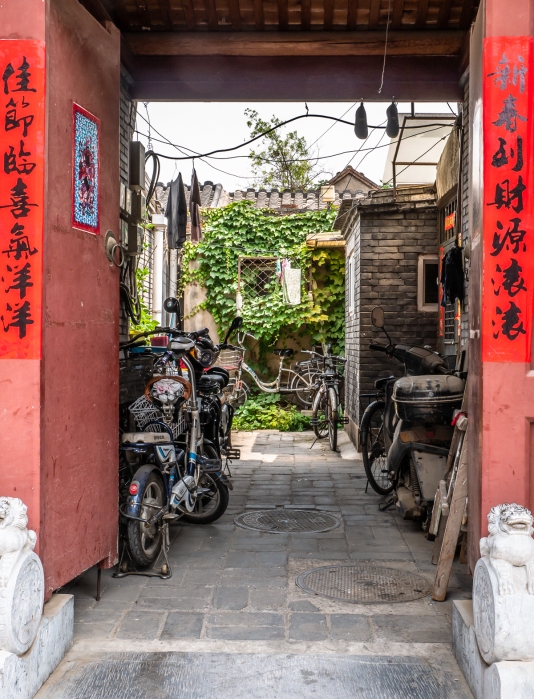
and alleys that lead deeper into evermore mysterious places.
In a large open area the trees are hung with festive red lanterns. It feels alive, open, friendly, safe. People come and go,
some sit playing mahjong, writing, chatting. There is a mail delivery,
and in the small alleys that lead from this space there is the daily life of a deeply intimate, and ultimately ordinary neighbourhood.
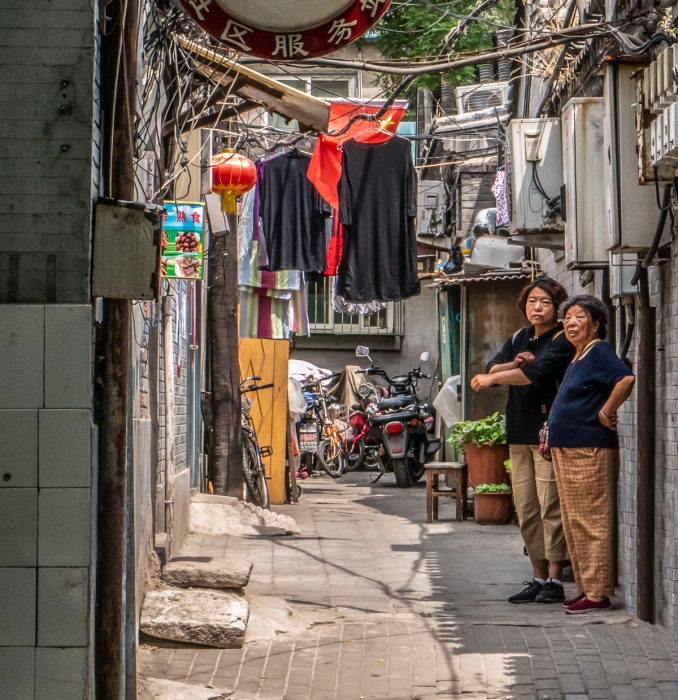
Many of the hutong areas have been razed to be replaced by new roads and modern multi-story dwellings. Now there is an effort to save those that are left. Some areas have been preserved and renovated, but in some places the ancient pathways are still visible, bricks laid down hundreds of years ago, worn with time and thousands, probably millions, of feet passing over them.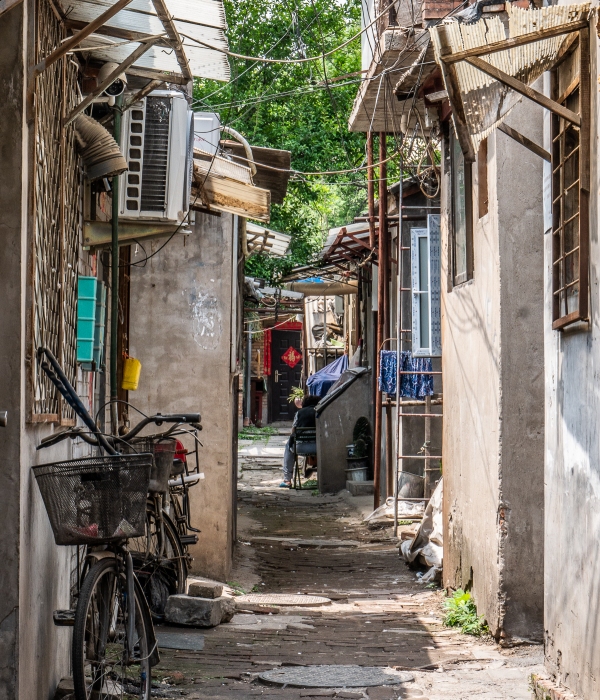
When I first go into a hutong area, alone, I don’t know what to expect. I just follow streets labelled “hutong” on the map, and discover these plain grey streets and alleys, with very little apparent life in them. What I don’t realise until afterwards is that the wide-open space with the red-lanterned trees is also part of the hutong neighbourhood. I begin my search feeling a little disappointed but immensely curious. I end it back at the hotel thoroughly beguiled.
On the way back to the hotel I see a line-up of people in one of the alleys leading off Red Lantern Square (as I’ve called it) and immediately go there to see what they’re lined up for.
What I find is the local hutong bakery, barely more than a hole-in-the-wall. In this tiny space four people are making, baking, and selling bread and everyone is lined up to get it fresh from the oven.

The aroma wafts out to welcome me and I join the line. For pennies I buy a bag full of the hot round flat bread. It’s too hot to eat right away but as it cools I eat while walking the short distance back to the hotel. It’s so good! There is nothing like fresh bread straight from the oven and my heart is warmed along with my belly.
Peter takes us to make dumplings somewhere in one of the hutong areas. In a small room that seems to be part house, part restaurant dining room, he shows us how. He makes several tiny, perfectly shaped dumplings, each one different, and good enough to be served in any restaurant. After much deep concentration from us a pile of oddly shaped lumps appears.
We are much like a bunch of kids with play dough. I’m not very good at it. Some of the others do better, but none of us quite match Peter’s skill.
And then comes a great surprise. At least it is to me. The Cricket Man appears. He speaks little or no English but his personality and energy fill the small room. He has been breeding fighting crickets all his life and clearly he is something of an expert, and a celebrity, in his field.
Cricket fighting has been popular in China for over a thousand years. It is not illegal, though gambling on it is, which doesn’t seem to stop it. The sport is huge. In 2010 more than US$63 million was spent on crickets and cricket fighting paraphernalia. They are sold openly in street markets and are carefully bred by expert keepers who feed them ground shrimp, red beans, goat liver and other delicacies. These are very pampered little crickets. In fights they are arranged by weight class, and the loser is the first to turn away from the battle. Rarely are they injured, and even more rarely killed. It’s kind of like cock fighting in miniature and without the blood.
The sport is taken very seriously. There is a national governing body of cricket fighting and the National Cricket Fighting Championships are held every year in Beijing. More than twenty teams from across China compete. There is no gambling at this event, or none that is overt anyway. Winning is for the honour and prestige. In a small smoky room nearby, fans can watch the matches live as they are broadcast onto a screen. We however are content to have Cricket Man show us his tools of the trade, and, of course, his crickets.
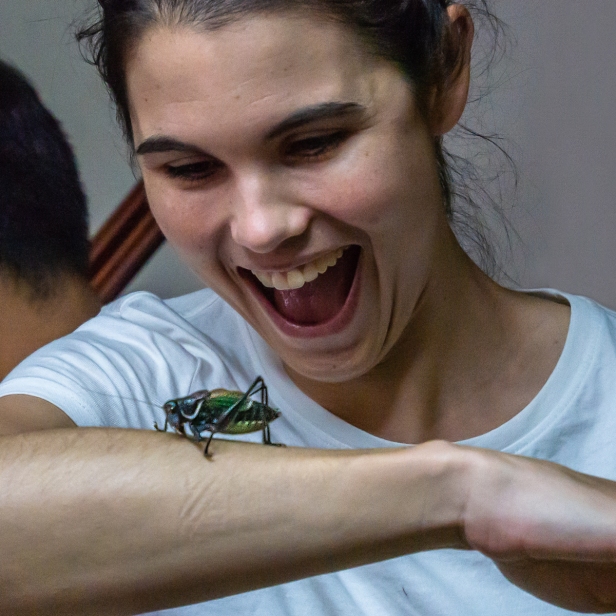
A short walk brings us to the rickshaw taxi stand.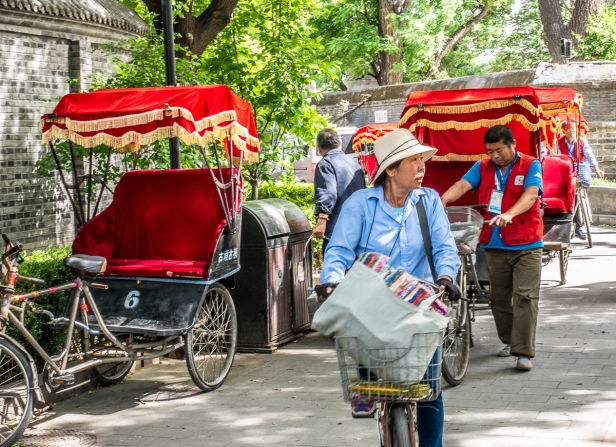
Two by two we climb in and roll off into the neighbourhood. It feels swift as lightening, racing through the streets, some wide enough for cars, some very narrow, twisting and turning around this bend and that, no explanation, so much to see, and no time to take it in. It’s fun, but no way to document the area. All I can do is take some quick snaps to try to capture the flavour of it.
Intriguing doorways surrounded by red for luck and with the traditional ancient stone carvings at the base,
a tiny hardware store, a small convenience store, a fruit and vegetable store, it’s contents spilling out into the street,
a dress store with a renovated shop front but still with the tell-tale traditional grey tile roof, enticing glimpses into courtyards and lanes accessorised with bicycles and dressed with laundry.

There’s a wall with big clay pots inlaid into the brickwork, a tiny shop selling food seeds, an abandoned auto-rickshaw and pedicab both of which have seen better days, and motor scooters parked anywhere they can fit.
It’s a lived-in residential neighbourhood full of the character that comes from years of seasoning, dotted with diminutive stores catering to basic daily needs, and communal bathrooms (and kitchens) for the many homes that don’t have private facilities.
There are people around but it’s quiet. Nobody’s rushing anywhere.
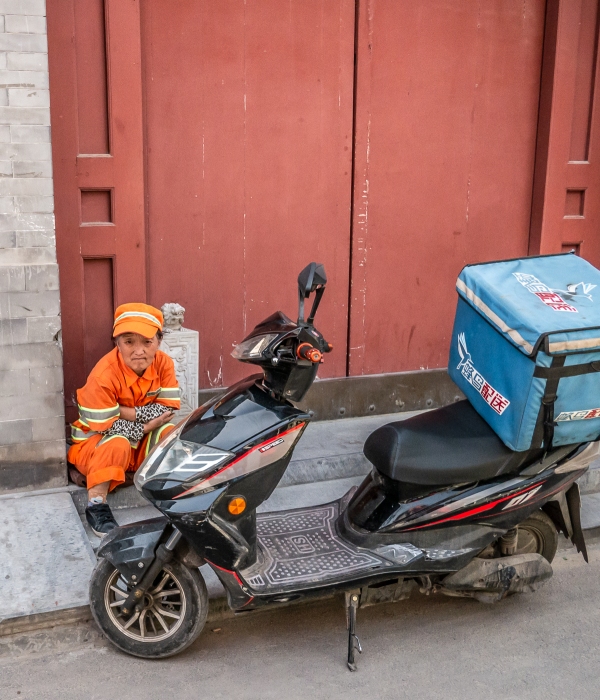
Some streets are tree-lined, their branches full with late spring leaves providing welcome shade. Sometimes I see tall trees that are obviously growing in one of the inner courtyards.
Peter tells us that many young people are leaving the siheyuan for modern apartments. I can relate to the temptation but they then miss out on the sense of history and belonging that comes from being in a home that has been in the same family for many generations. Life in the hutongs has both its advantages and disadvantages. It’s cosy and intimate with a groundedness that comes from years of existence. The feeling is laid back, as if time has slowed down. On the other hand the houses are butted up against each other, and some courtyards have been filled in with even more homes. There’s no escaping your neighbours. The sense of community is strong, but lack of privacy and modern amenities can be an issue.
At the end of the rickshaw tour we arrive at the large open area between the Drum Tower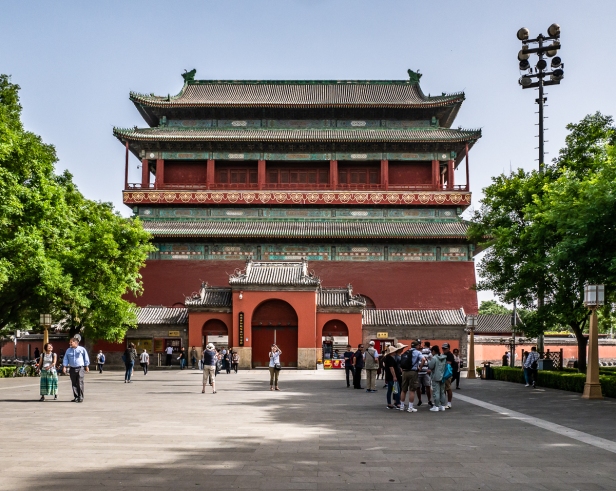
and the Bell Tower.
As long ago as the Han Dynasty (206 BCE-220 CE) there was a morning bell and an evening drum to help people keep track of time, and drum and bell towers are found in most Chinese cities. The Beijing towers, dating from the Ming Dynasty, were used for official timekeeping up until 1924, and for years dominated the skyline. The space between them was at one time filled with shops and businesses. These days it is an open public space frequented by tourists and used by the people of the nearby hutongs.
It is in these open public squares that the people of the hutongs have the space to spread out and come together. Groups gather to play Mahjong,
or Go
or Chinese Chess
or use the wide open space for a game of roller hockey.
Walking on from there we come to an area that has seen modern development while preserving the feel of the hutong neighbourhood. Buildings that still retain the iconic grey roof tiles and brick walls have been renovated and some converted into hotels, cafes, and restaurants.

There are pottery shops, dress shops
and antique shops.

The hutong neighbourhoods are the living history of the city. The more I learned about them the more I came to appreciate them. Because they are so old every street has a story or anecdote from earlier times. They were the birthplace of the Beijing Opera and the first Chinese stock market. The houses are ramshackle and it’s all a bit rundown, but these historic areas have been a vibrant part of Beijing life since the 13th century, and today they are about as far as you can get from the modern Beijing of multi-story buildings, designer stores, trendy bars, and neon lights. And with the movement to save the remaining hutongs, and the continuing renovations perhaps it’s not yet the last days of old Beijing.
Next post: Tiananmen Square and the Forbidden City
All words and images by Alison Louise Armstrong unless otherwise noted
© Alison Louise Armstrong and Adventures in Wonderland – a pilgrimage of the heart, 2010-2019.

Fascinating photos Alison. My mother went here on her own, with an academic visa, before China was open to western travelers. So interesting.
LikeLiked by 1 person
Thanks Cindy. It must have been amazing when your mother was there. What a journey for her! I first went to China in 1978 when the borders had just been opened to foreigners and you could only enter on a government tour. I only went as far a Guangzhou (formerly Canton) in the south. It was pretty incredible. Everyone was still wearing blue Mao pyjamas.
Alison
LikeLike
Steven and I stayed in a hostel in one of the hutongs for several nights on our first overseas trip together way back in 2013. I remember so vividly my own experience of wandering by myself through the hutong first thing in the morning to get a sense of how people lived and shopped. Your post brought back some very special memories for me – thank you.
LikeLiked by 1 person
You’re so welcome! It must have been amazing to stay there. I was initially both enthralled and puzzled by the grey alleyways. My first introduction to the hutongs was to stumble upon a completely residential area and everyone was either inside or at work. It seemed very private and I felt like a bit of an interloper.
Alison
LikeLike
Wonderful walking along with you through the hutongs, Alison; those are the kinds of places I like to explore when I travel. These are fabulous photos and I feel like I’ve been there. Thanks!
LikeLiked by 1 person
Thank you so much Suze. A lot of the photos were quick snaps as we rolled along in the pedicabs. I wish we’d had more time. I’m always looking for these kinds of places too – trying to get a sense of how ordinary people live. I still find it fascinating even after all the travelling I’ve done. I’m glad you felt like you went there too – that’s what I aim for.
Alison
LikeLiked by 1 person
amazing illustrated Chinese adventure
with diverse excursions,
thru narrow passages
to safe exotic new sensations
for all the senses 🙂
LikeLiked by 1 person
Thank you David.
These alleyway travels
were definitely an exotic
feast for all the senses.
Entering another world
and finding ultimately
people like you and me.
Alison
LikeLiked by 1 person
What a wonderful tour and series of images. Makes me feel as though I’m walking with you around the area.
Such a unique ‘slice of life’ – thanks for sharing.
LikeLiked by 1 person
Thank you so much Vicki. It was an amazing place to explore, and as you say, a unique slice of life. I’m glad you felt like you were walking there too!
Alison
LikeLiked by 1 person
There was so much to love in this post. Beautiful photos – love the one of the lady with the cricket on her arm especially. And those doorways – made me want to step through and explore. It reminded me a little of the medinas in Morocco – the same kind of enticement. But cricket fighting was the real eyeopener! The things people do are so mind-blowing!
LikeLiked by 1 person
Thanks so much Tracey. I found the doorways so enticing. I’d love to have been able to go inside some of them and see the courtyard homes. So curious.
Yeah! Cricket fighting! Isn’t that amazing! I’m continually blown away by the things people think up to do!
Alison
LikeLiked by 1 person
Sounds fascinating and just like the kind of historic exploration I love to do in cities… getting to their core and walking the streets observing people going about their day. My favorite of all the wonderful photos are the one of the chess players and the elderly woman.
Ben LOVES peking duck, rolled in a crepe. I think its called Mu Shu duck and even though I am not a big meat eater, I have tried it and loved it. Its his favorite thing to order in Chinese restaurants. The meal looks yummy.
Peta
LikeLiked by 1 person
I too love exploring the old towns, and I’m constantly amazed by how few people go into the smaller lanes and alleys – all over then world. I just want to turn every corner and see what’s next. I can’t always of course, but places like the hutongs were so enticing for me. I knew right away that they were safe places so I could explore as much as I wanted, though I’d have loved to have gotten a look inside one of those doors to the inner courtyard.
Your two favourite photos are also my two favourites. Especially the old woman with the movie post behind her. What a juxtaposition!
The meal was fabulous. Almost all the meals there were only I had to deal quite often with too much chilli. Don’t like spicy food. Sichuan was a challenge.
Alison
LikeLike
I love this post! The hutongs are fascinating, and beautiful in their own way. I started to think ‘oh, ohh’ as you began the cricket fighting story, worried by how it would play out for the poor creatures; must admit I was relieved to read that the crickets don’t usually come to too much harm, they’re stunning.
LikeLiked by 1 person
Thanks so much Amanda! I wish I’d known more about them before I went. As usual I do most of my research afterwards and almost always regret it because I think I’d see things differently if I knew a little more about what I was looking at. Anyway, I am pleased that for the most part I was not in the touristy parts of the hutongs. I got to see the more down home residential areas which I found fascinating.
I also was pleased to read that the crickets are mostly safe. I think some do get injured, but mostly not, and for one to be killed is apparently quite rare. It continues to blow me away what people find to do. Whoever would have thought of making a sport out of cricket fighting?!
Alison
LikeLike
Great street scenes that show glimpses of life.
LikeLiked by 1 person
Thanks rabirius. It really was just a glimpse. I’d love to have been able to explore deeper, but what I did see was pretty fascinating.
Alison
LikeLike
Yes. I can see that. Really fascinating pictures.
LikeLiked by 1 person
ohh what a beautifully evocative post! I’ve heard of the hutongs, but didn’t know much about them. Good to know they’re working to preserve them now. I’ve never been to China, it’s moving higher up my list now! And such photos, as always. Those faces, often the best thing about travel for me!
LikeLiked by 1 person
Thank you so much Danila. The hutongs were a field of slowly unfolding awe for me. I had no idea what to expect, but was richly rewarded with a glimpse into the ordinary life of the people in this part of the city. So down-home and real. And yes the people are often the best thing for me too.
Alison
LikeLike
You are a master story teller, triggering each sense so delightfully, generating many an emotion.
The pictures I am ,most drawn to here are the first and the last. The first because I have struggled to frame such iindoor scenes and to capture them so clearly in low light. You have done well. The last because that face tells a thousand stories.
I adore what you have founding on the hutongs. How I would love to meander such alleyways with something new and exciting to be found around very corner.’
And that Cricket Man with his pit bull size fighter (in relative terms to other crickets) was an unexpected surprise
Once again, you have me longing to go to Beijing
LikeLiked by 1 person
Thank you so much Lisa! What a wonderful compliment. I will remember it as I struggle to craft future posts. Coming up is the Forbidden City and there is so much info about it that I’m drowning in facts but I have yet to find the *life* in it!
Thank you re the first pic. Lightroom helps a lot 🙂
The last pic is I think, my favourite photo of the whole tour of China. It was a lucky shot, and at the same time I’m immensely proud of it.
As so often happens when I’m travelling I wish I’d had more time – those hutongs could do with a lot more exploring!
I’d never heard of cricket fighting. The things you learn along the way! The things people think up to do!
Alison
LikeLiked by 1 person
Such wonderful memories you have brought back! In both of my trips to Beijing, my favorite part was the hutongs. They were the big-city China I never knew still existed, and while they were clearly living, breathing current homes, there was so much history present. (I’ve never heard of the cricket fights, though! Very glad to hear no harm is done to the little creatures.) As always, your photos capture the colors, textures, and feelings of this place so well.
LikeLiked by 1 person
Thanks so much Lexie. I knew very little about the hutongs. My sisters had both been to China fairly recently and said I had to see the hutongs in Beijing, but I didn’t know what that meant until I got there. I’m so glad I had time to explore a little bit.
The crickets were a complete surprise to me. I’d never even heard of it! The man who showed them to us said that if he showed us a fight one of the crickets would die, but I think he was exaggerating for effect a bit. When I researched it I found out that injury is not that common and death even less so. The weaker one simply walks away.
Alison
LikeLiked by 1 person
Your photos capture such great spirit and the heart of a culture ~ brilliant. A couple decades ago, these hutongs were also my playground, with a couple friends living there and there was nothing better than getting an invite for dinner 🙂
LikeLiked by 1 person
Thank you so much Randall. I especially appreciate your compliment since you lived there (or near enough?) and know what the neighbourhood is like from inside out, so to speak. I only got a glimpse really, but I could feel both the uniqueness, and the ordinariness, of it. It was a wonderful exploration for me. How amazing it must have been to have such a timeless and grounded place as your playground.
Alison
LikeLike
What was special, was during my time in Beijing (early 90s), I lived in a high rise that overlooked a hutong, and looking down I could see what a different world it was down there versus “life on the outside.” I miss those moments.
LikeLiked by 1 person
It’s sad to hear that hutongs are quickly becoming a thing of the past – or that they’ll just be a tourist area. But, on the other hand, I’m reminded of what Gulya, a guide we’d hired to take us around the Jewish part of Bukhara, said about the old town: “Why would I want to live in an old cramped house with little light, faulty plumbing and damp when I can have a modern apartment with better views, healthier air and aircon?”. Can’t really fault her!
LikeLiked by 1 person
I also can’t blame people for wanting modern accommodation. The good news is that from what I’ve read it sounds as if the hutongs will be saved and upgraded. There are big plans afoot. They will not be retained exactly as they are, but I think the idea is to retain the alleys/lanes as they are, and to also retain the character of the buildings, but upgrade them to modern standards. No doubt this will take years, area by area, but at least there is a movement to save them.
Alison
LikeLiked by 1 person
I remember the Hutongs in Beijing and loved exploring them. Sadly all my photos are masked in pollution as it was awful when I went. Gorgeous photos of this amazing secret world Alison.
LikeLiked by 1 person
Thanks so much Nicole. That’s too bad about the pollution. It hasn’t all gone of course, but sounds as if it’s better now than when you were there.
I had no idea what to expect with the hutongs. I’m glad I got to explore them a bit.
Alison
LikeLiked by 1 person
Yes the pollution was so bad when I was there that none of my pictures are clear. But nevertheless I found it fascinating
LikeLiked by 1 person
Amazing pictures as always. The Hutongs are indeed a very interesting area to visit: a bit of the old China we expect to see as tourists.
Loved your description of Peking Duck. I am surprised this dish is not known or popular in Canada. I teamed up with a Canadian tourist in Beijing (she stayed at the same hostel as me) and she also had never tasted Peking Duck before. Definitely one of my favourite Chinese dishes.
Lieve
LikeLiked by 1 person
Thanks so much Lieve. What I enjoyed about the hutongs was that most of the ones I explored were not touristy at all, but ordinary residential neighbourhoods. I’m glad there’s a movement to save the ones that are left. But yes, they are a part of the tourist trail and the pedicab tour was very touristy even though it was mostly through a residential area.
Peking duck was definitely a surprise. I expected some kind of roast duck, but certainly not wrapped in crepes.
Alison
LikeLike
A lovely and enriching exploration of historical China, Alison. I really enjoyed this. Those warrior crickets look like tiny dinosaurs! I don’t think I’ve ever seen crickets like that when roaming the wild, and thank goodness! I think I’d be the first to turn! So nice, as always, to see people through your lens, in their natural environments, just being who we all are. There is much here to savor, and I can relate to your sentiments about young people leaving these abodes of connection and culture for the commoditized modernity that so beckons. I’m grateful to have seen a glimpse of it here…
Peace
Michael
LikeLiked by 1 person
Thank you so much Michael. I’m glad you enjoyed my journey into the hutongs. I really enjoyed exploring this part of Beijing – it was so new for me, and unexpected.
I have seen crickets like that, in Australia where much comes in a larger size, so they were no surprise – except the colours! He had a black one, but I’ve never before seen a bright green one. The ones in Oz are brownish to match the summer dry grasses.
One of my favourite things is to capture people without them being aware of it – just being people, being, as you say, who we all are. As soon as I ask if I can take a photo, or lift the camera, almost everyone poses (I am probably the worst offender) and the unconscious naturalness is gone.
Alison
LikeLike
Another amazing experience. Your head must have been exploding with all the new sights, sounds, smells, tastes etc!!
LikeLiked by 1 person
Oh yes, it was amazing, and yes my head was exploding, and now it’s exploding even more trying to gather all the stories in and share them in a comprehensible way. It’s a fun part of the journey for me – this getting to relive and share it.
Alison
LikeLiked by 1 person
Your post sent me scurrying off to explore cricket fighting, Alison. I’d never heard of it before. I discovered that they weigh the little buggers before the fight, get them stirred up and then let them go at it. Big teeth, a strong neck and long legs are important! A prime fighter can be sold for up to $1500! Apparently the sport has little appeal to the younger generation. After a thousand years, cricket fighting may be on its way out. I always find something of interest in your posts. Thanks. –Curt
LikeLiked by 1 person
I’d never heard of it before either! Isn’t it amazing, and weird, and intriguing. I did the same research – still completely gobsmacked by it. Endlessly amazed by the things that people think up to do. $1500 for a creature that anyway only lives for about 100 days! Crazy!
Alison
LikeLike
$1500 for a common insect! My thoughts exactly. 🙂 Yet I can’t help but wonder how much money an owner might make off of his or her champion. Somehow I am reminded of Mark Twain’s jumping frogs. (grin) –Curt
LikeLiked by 1 person
Another fascinating article with amazing photography. You bring the place to life and I feel I am walking with you. You were very brave to walk through the hutong area alone, and you were rewarded with a fascinating insight into how the locals live. I really liked that phrase “a badling of ducklings”. It painted a perfect picture! Thank you, Alison xx
LikeLiked by 1 person
Thank you so much. It was an interesting exploration for me. I never felt that I was unsafe, more that I may be intruding a bit. It’s always so interesting to me to see how others live.
I looked up the word for a group of ducks and was tickled to find it’s badling. Isn’t it a great word!
Alison
LikeLiked by 1 person
Cricket fighting? I have learned something new. Your curiosity is infectious Alison and I love your explorations in these fascinating neighbourhoods. You’ve got me hankering for that peking duck!
LikeLiked by 1 person
Thanks so much Caroline. I too was surprised, and amazed by cricket fighting. I loved exploring the hutongs. Wish I’d had more time there.
Alison
LikeLike
This story is fascinating ! beautiful ! and wonderfully written !
LikeLiked by 1 person
Thank you so much Jadi. I’m glad you enjoyed it.
Alison
LikeLike
I realized just now that I missed this post earlier – but better late than never because I enjoyed it very much. 🙂 Thank you, Alison!
LikeLiked by 1 person
Thanks so much Lynn. Beijing is mostly very modern now, so it was fascinating to be able to explore this quieter and, I suppose more authentic, side of the city. It felt homey.
Alison
LikeLike
That makes sense – I’ve read about the hutongs and the problems with development in Beijing, but your post brought it to a more personal, real level.
LikeLiked by 1 person